Abstract
Visual field defect is a type of ophthalmic disease which causes the loss of a portion of the field of view. It is a common sequelae of stroke, traumatic brain injury, and brain tumors. Among all VFDs, hemianopia is a common type, indicating half visual field loss. The popularity of computational glasses has brought possibilities for exploring new solutions to intractable ophthalmic problems. Developers design their own computational glasses that are specialized for particular eye diseases or make assisting software that runs on commercially available head-mounted displays.
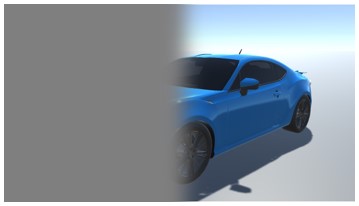
The purpose of this project is to extend the visible range of hemianopia patients using an optical see-through head mounted display (OST-HMD). Then, we clinically verify that the proposed technique can achieve the effect of adaptive visual enhancement that was difficult with conventional optical instruments and simple image conversion.
Projecting a reduced real-time video within the visible range of the patient can prompt the picture of the invisible area while retaining the contextual information. The patient can detect obstacles and dangers in the invisible range through the real-time video, which is called overview window. A series of experiments, such as the whac-a-mole task, were designed to optimize the configuration of the overview window.
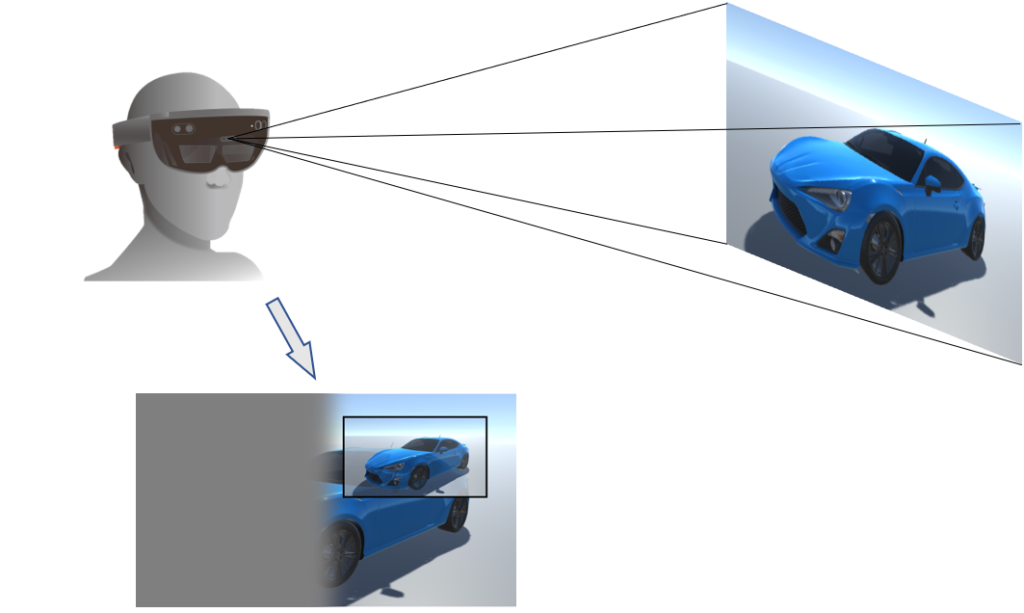
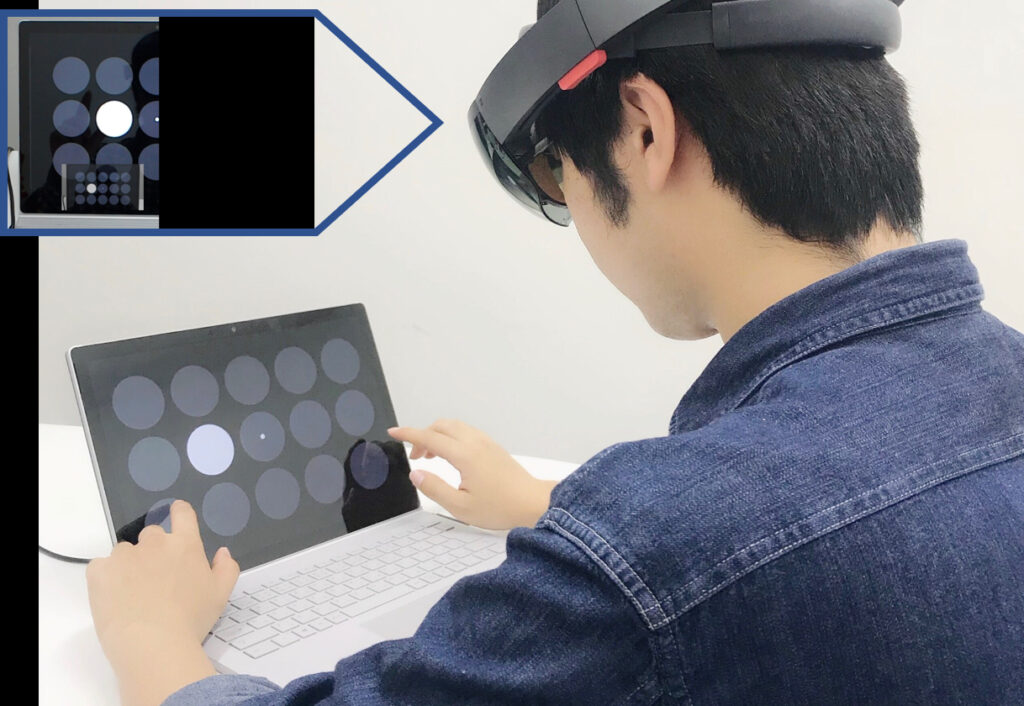
Another way of assisting hemianopia patients is to display indicators at the boundary of the visible visual field, as shown in the figure below. This method comes from the aspect of indicating the events happening in the blind side, instead of directly showing the image of the invisible area. The indicators help the patients to detect unseen information in advance to avoid danger and response to the events intuitively.
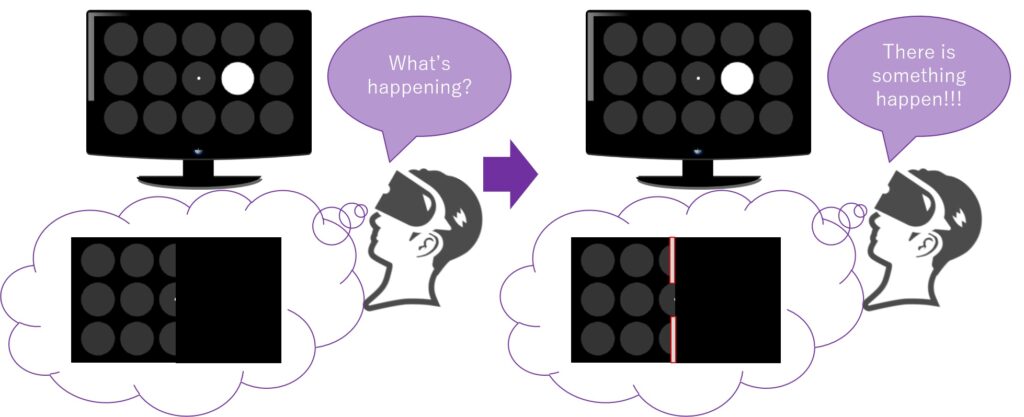
Computational Ophthalmology and SAM
Computational ophthalmology is a typical embodiment of the SAM concept. It is a general term for technologies that make use of augmented reality technology and virtual reality technology to improve the quality of social life for the visually impaired.
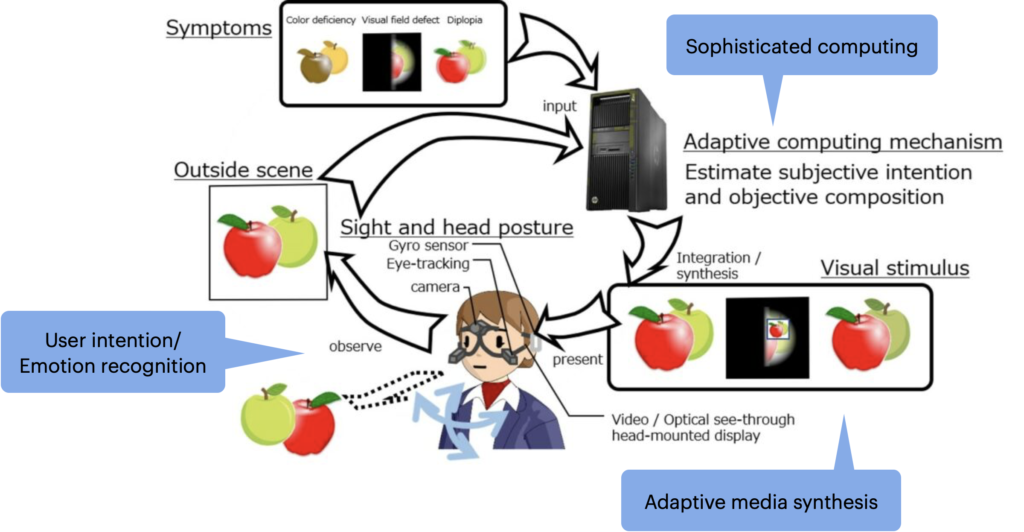
In Computational Ophthalmology, eye tracking sensors and gyro sensors are used to acquire the visual field information of the user, based on which the real-time scene captured by the front-facing camera can be adaptively computed and output to the screen to the head mounted display. This process constitutes the core concept of SAM, the so-called Human-in-the-Loop.
Members
| Name | Affiliation | Web site |
|---|---|---|
| Keio University | ||
| Xiaoyang Mao | University of Yamanashi | Mao Laboratory staff profile |
| Kenji Kashiwagi | University of Yamanashi | University of Yamanashi staff profile |
| Go Kentaro | University of Yamanashi | University of Yamanashi staff profile |
| Masahiro Toyoura | University of Yamanashi | University of Yamanashi staff profile |
Publications
Journals
- Zhenyang Zhu, Masahiro Toyoura, Kentaro Go, Kenji Kashiwagi, Issei Fujishiro, Tien-Tsin Wong, Xiaoyang Mao: “Personalized image recoloring for color vision deficiency compensation,” IEEE Transactions on Multimedia, March 2021 (early access) [doi: 10.1109/TMM.2021.3070108]
- Zhenyang Zhu, Masahiro Toyoura, Issei Fujishiro, Kentaro Go, Kenji Kashiwagi, Xiaoyang Mao: “LineM: Assessing metamorphopsia symptom using line manipulation task,” The Visual Computer, February 2021 (online first) [doi: 10.1007/s00371-021-02091-9]
- Xi Zhao, Issei Fujishiro, Kentaro Go, Masahiro Toyoura, Kenji Kashiwagi, Xiaoyang Mao: “Enhancing visual performance of hemianopia patients using overview window,” Computers & Graphics, Vol. 89, pp. 59—67, June 2020 [doi: 10.1016/j.caj.2020.04.001].
Conferences
- Changtong Mao, Kentaro Go, Jianjun Li, Yuichiro Kinoshita, Kenji Kashiwagi, Masahiro Toyoura, Issei Fujishiro, Xiaoyang Mao: “Different eye movement patterns on simulated visual
field defects in a video-watching task,” poster in Proceedings of Cyberworlds 2020 , pp. 153–156, September 29–October 1 (presentaton day: September 30), 2020 [doi:10.1109/CW49994.2020.00033]. - Keisuke Ichinose, Xi Zhao, Issei Fujishiro, Masahiro Toyoura, Kenji Kashiwagi, Kentaro Go, Xiaoyang Mao: “Visual field loss compensation for homonymous hemianopia patients using edge indicator,“ in Proceedings of Cyberworlds 2020, pp. 79–85, Caen, France, September 29—October 1 (presentation day: September 29), 2020 [doi:10.1109/CW49994.2020.00019]
- Lina Chen, Kentaro Go, Yuichiro Kinoshita, Kenji Kashiwagi, Masahiro Toyoura, Issei Fujishiro, Xiaoyang Mao: “Using an eye tracking device to discriminate different symptoms in glaucoma,”
short paper in Proceedings of Cyberworlds 2020, pp. 141–144, September 29–October 1 (presentaton
day: September 30), 2020 [doi: 10.1109/CW49994.2020.00030]. - Xi Zhao, Kentaro Go, Kenji Kashiwagi, Masahiro Toyoura, Xiaoyang Mao, Issei Fujishiro: “Computational alleviation of homonymous visual field defect with OST-HMD: The effect of size and position of overlaid overview window,” in Proceedings of Cyberworlds 2019, pp. 175—182, Kyoto, Japan, October 2—4, 2019 [doi: 10.1109/CW.2019.00036].
Presentations
- Lina Chen, Changtong Mao, Kentaro Go, Xiaoyang Mao, Masahiro Toyoura, Kenji Kashiwagi, Zhenyang Zhu, Hiromichi Ichige, Ying Tang, Issei Fujishiro, Xi Zhao, Yuichiro Kinoshita: “Use of an Eye-tracking Device for the Detection of Visual Field Defect,” The Virtual Reality Society of Japan 69th Cyberspace and Virtual City Research Society, VR Research Report, Vol. 25, No.CS-1, CSVC2020-2, pp. 9―13, February 26, 2020 (in Japanese).